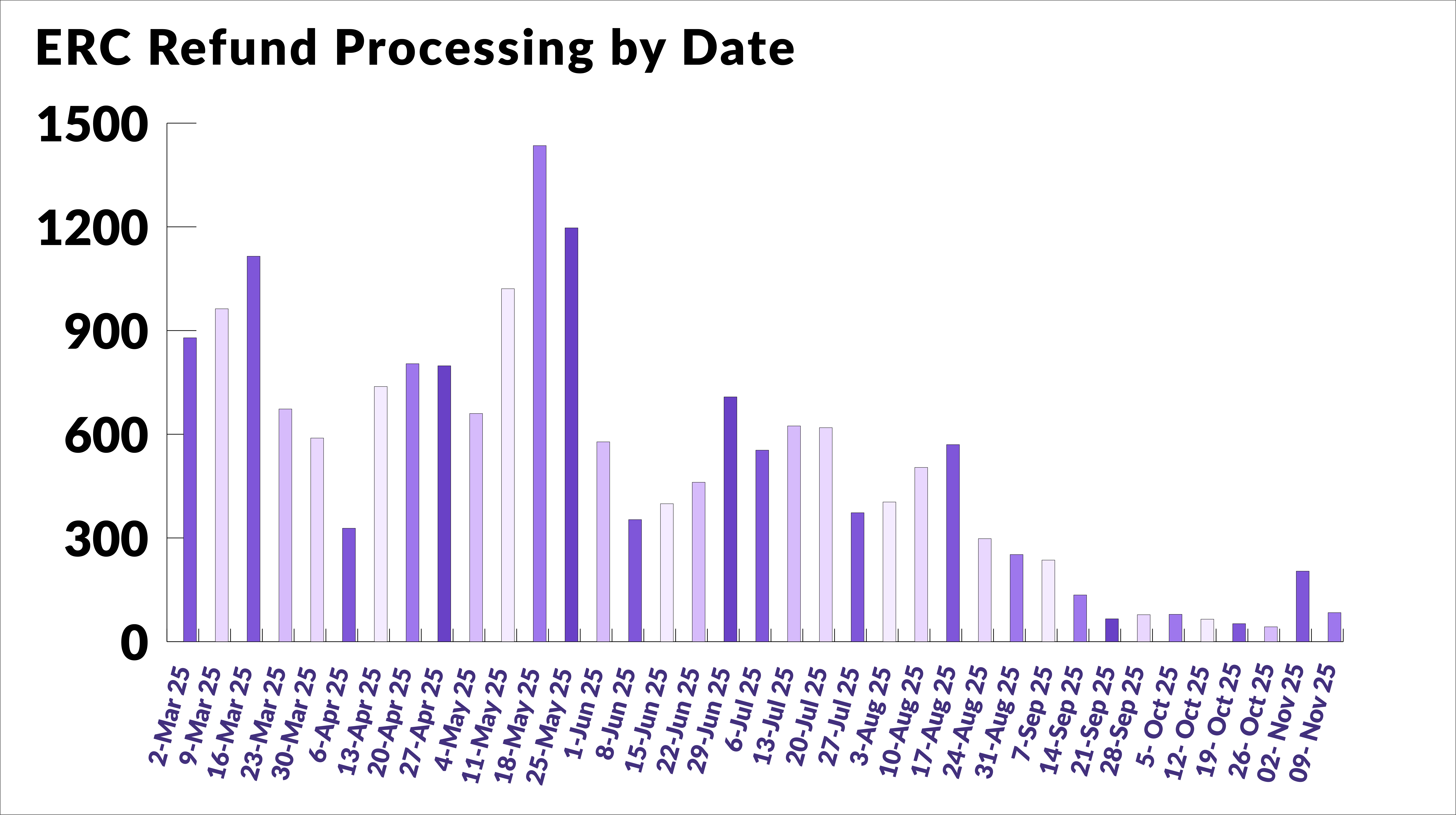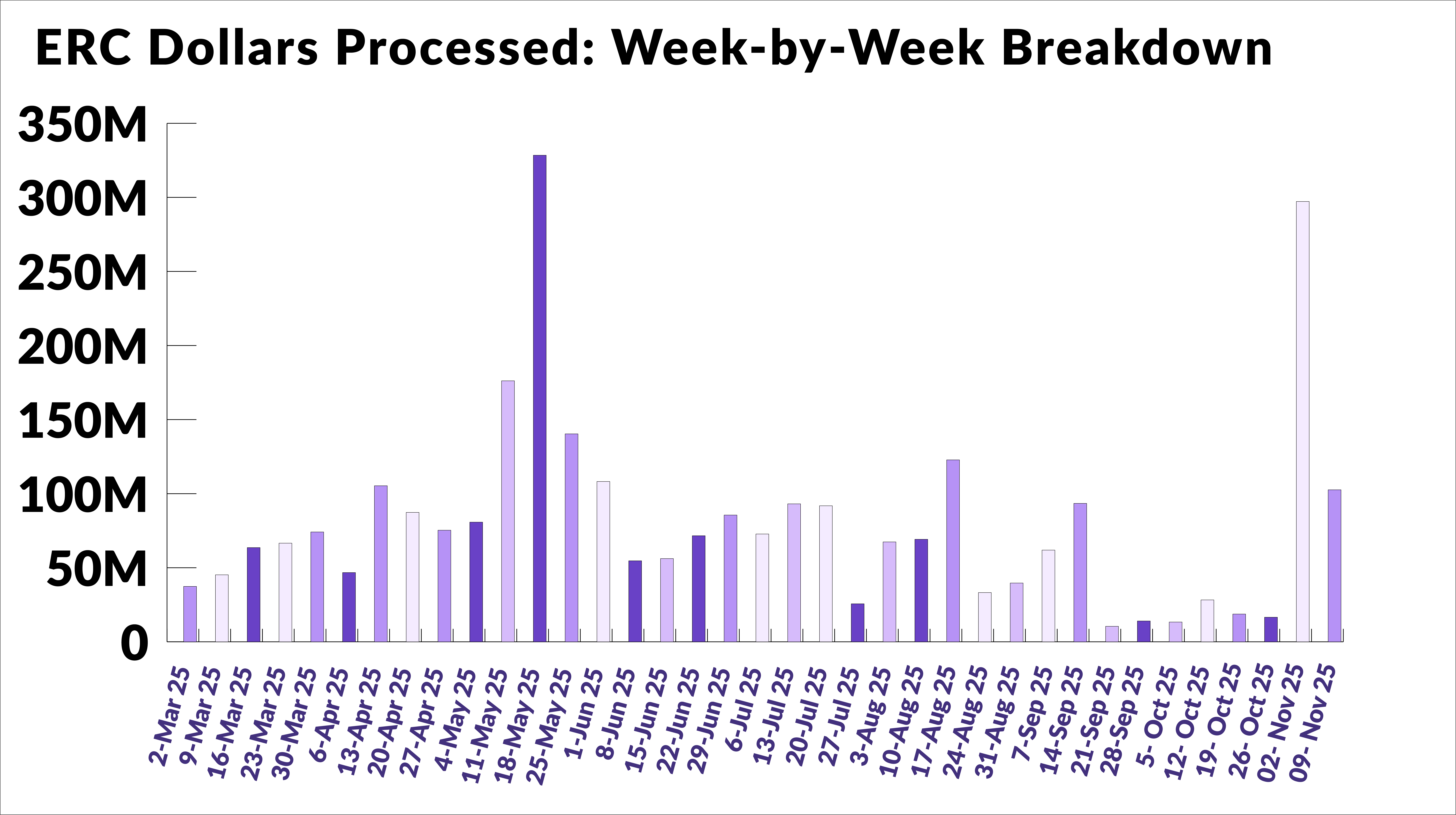
After last week’s burst of ERC optimism, reality appears to have reentered the building. Both ERC refund volume and dollar totals fell sharply, validating much of TaxNow’s earlier theory that the recent “surge” was likely a one-off administrative release of large, previously held claims. This week’s data shows activity settling back toward pre-spike levels, and if this trend continues, we may soon find ourselves right back in the ERC doldrums.
The numbers tell a fairly clear story: fewer than 100 total claims were processed this week, down more than 50% from last week’s total. Total dollar volume was cut to just a third of last week’s total, and while the average refund remains north of $1 million per quarter, the IRS’s pace once again appears erratic and unsustainable.
In the words of the great Lily Tomlin, “What goes up must come down, but don't expect it to land where you can find it!"
📉 Total refunds processed: 84, down from 204 last week.
📉 Total dollar volume: $102.61 million, down from $297 million.
📉 Average refund amount: $1,221,496, which remains steady, but may be artificially high due to larger claims being pushed through. We did observe proportionately more sub-$500k refunds last night, but we’re not ready to read too much into that with only 84 total refunds across the field.
📉 Average processing time: 619 days, shorter than last week’s 701, but certainly nothing groundbreaking to report.


1. IRS Casework Is in Shambles - Ongoing IRS furloughs are wreaking havoc on Capitol Hill casework, with congressional offices from both parties reporting stalled or completely frozen constituent IRS cases due to the shutdown of the Taxpayer Advocate Service (TAS). All TAS offices are closed, operating with just 93 of roughly 1,500 employees, leaving lawmakers unable to help constituents resolve delayed refunds, including ERC claims. Staffers report growing backlogs, dropped calls, and months-old cases now at a standstill.
The National Taxpayer Advocate has already lost 25% of its workforce this year, and with additional reduction-in-force notices sent to Treasury employees, recovery seems unlikely anytime soon. Democrats blame the Trump administration’s political interference and furlough decisions, while Republicans point to Senate inaction on funding bills, but both sides agree that taxpayers are the ones paying the price.
2. DOJ Tax Winddown is Stalled by the Shutdown - The Justice Department’s plan to dismantle its Tax Division and transfer its functions across other DOJ branches is moving forward, albeit slowly, amid ongoing shutdown-related furloughs. Former Tax Division head Karen Kelly confirmed that the civil tax function is being folded into the Civil Division, while the criminal tax function will shift under the Criminal Division by early November.
The reorganization, coupled with severe attrition, roughly one-quarter of staff lost in 2025, is expected to disrupt ongoing and future tax litigation. Experts warn that eliminating a centralized, tax-specialized division will erode consistency in enforcement and slow down complex cases, particularly those involving the IRS and DOJ collaboration. Pending ERC litigation cases are also likely to feel the ripple effects once the DOJ Tax Division is fully dismantled, as coordination and case strategy across U.S. attorney offices become more fragmented.
3. No End in Sight for the Shutdown - The federal government shutdown has now stretched into its fourth week with no deal in sight, as partisan gridlock continues to stall funding negotiations. More than 800,000 federal employees remain furloughed or working without pay, while critical programs like SNAP and Head Start face imminent funding lapses.
IRS operations remain severely limited, with the Taxpayer Advocate Service fully shuttered and refund processing at a crawl. Flight delays, service backlogs, and growing economic strain are amplifying pressure on Congress to strike a compromise, but for now, taxpayers, particularly those awaiting ERC refunds, continue to bear the brunt of the shutdown’s ripple effects.
Kenny's Conclusions
Our working theory from last week, that the IRS temporarily released a batch of “large-claim holdovers,” appears to be holding up. The data now looks more like a clearing event than a genuine turnaround. If that’s true, this latest dip signals that the underlying pipeline of truly active ERC processing remains largely dry.
The next few weeks will be critical in assessing what’s actually going on during the shutdown for ERC processing. If refund counts continue to fall, it will confirm that the October surge was a one-time anomaly. In that case, we’re likely staring down another prolonged dry spell for claimants.
Signing off!
Kenny Dettman, CPA
Disclaimer: *𝘋𝘢𝘵𝘢 𝘴𝘦𝘵 𝘪𝘴 𝘧𝘳𝘰𝘮 𝘢𝘱𝘱𝘳𝘰𝘹𝘪𝘮𝘢𝘵𝘦𝘭𝘺 14,000 𝘣𝘶𝘴𝘪𝘯𝘦𝘴𝘴𝘦𝘴 𝘵𝘳𝘢𝘤𝘬𝘪𝘯𝘨 𝘌𝘙𝘊*